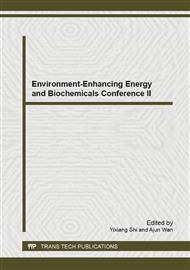[1]
G. Huang, et al., Biodiesel production by microalgal biotechnology, J. Applied Energy. 87 (2010) 38-46.
Google Scholar
[2]
Y. Cheng, et al., Alga-Based Biodiesel Production and Optimization Using Sugar Cane as the Feedstock, J. Energy & Fuels. 23 (2009) 4166-4173.
DOI: 10.1021/ef9003818
Google Scholar
[3]
R. Munoz, and B. Guieysse, Algal-bacterial processes for the treatment of hazardous contaminants: a review, J. Water research. 40 (2006) 2799-2815.
DOI: 10.1016/j.watres.2006.06.011
Google Scholar
[4]
T.A. Milne, R.J. Evans, N. Nagle, Catalytic conversion of microalgae and vegetable oils to premium gasoline, with shape-selective zeolites, J. Biomass. 21 (1990) 219–232.
DOI: 10.1016/0144-4565(90)90066-s
Google Scholar
[5]
Y. Dote, S. Sawayama, S. Inoue, T. Minowa, Yokoyama, Shin-ya, Recovery of liquid fuel from hydrocarbon-rich microalgae by thermochemical liquefaction, J. Fuel. 73 (1994) 1855–1857.
DOI: 10.1016/0016-2361(94)90211-9
Google Scholar
[6]
Xu H, Miao XL, Wu QY, High quality biodiesel production from a microalga Chlorella protothecoides by heterotrophic growth in fermenters, J. Biotechnol. 126 (2006) 499–507.
DOI: 10.1016/j.jbiotec.2006.05.002
Google Scholar
[7]
P.M. Fergola, Cerasuolo, et al., Allelopathy and competition between Chlorella vulgaris and Pseudokirchneriella subcapitata: experiments and mathematical model, J. Ecological Modelling. 208 (2007) 205-214.
DOI: 10.1016/j.ecolmodel.2007.05.024
Google Scholar
[8]
Liu ZY, Wang GC, Zhou BC, Effect of iron on growth and lipid accumulation in Chlorella vulgaris, J. Bioresource technology. 99 (2008) 4717-4722.
DOI: 10.1016/j.biortech.2007.09.073
Google Scholar
[9]
Hsieh CH, Wu WT, Cultivation of microalgae for oil production with a cultivation strategy of urea limitation, J. Bioresource technology. 100 (2009) 3921-3926.
DOI: 10.1016/j.biortech.2009.03.019
Google Scholar
[10]
A Soares B, Guieysse B, Jefferson E, Cartmell JN, Lester, Nonylphenol in the environment: A critical review on occurrence, fate, toxicity and treatment in wastewaters, J. Environment International. 34 (2008) 1033-1049.
DOI: 10.1016/j.envint.2008.01.004
Google Scholar
[11]
M Danger, C Oumarou, D Benest, G Lacroix, Bacteria can control stoichiometry and nutrient limitation of phytoplankton, J. Functional Ecology. 21 (2007) 202-210.
DOI: 10.1111/j.1365-2435.2006.01222.x
Google Scholar
[12]
L Travieso, F Benítez, E Sánchez, et al., Production of Biomass(Algae-Bacteria) by Using a Mixture of Settled Swine and Sewage as Substrate, J. Journal of Environmental Science and Health Part A. 41 (2006) 415-429.
DOI: 10.1080/10934520500428302
Google Scholar
[13]
Xavier Borde a, Benôıt Guieysse b, Osvaldo Delgado, Synergistic relationships in algal-bacterial microcosms for the treatment of aromatic pollutants, J. Bioresource Technology, 86 (2003) 293-300.
DOI: 10.1016/s0960-8524(02)00074-3
Google Scholar
[14]
Luz E, de-Bashan, Juan-Pablo Hernandez, Taylor Morey, Yoav Bashan, Microalgae growth-promoting bacteria as 'helpers', for microalgae: a novel approach for removing ammonium and phosphorus from municipal wastewater, J. Water Research. 38 (2004).
DOI: 10.1016/j.watres.2003.09.022
Google Scholar


